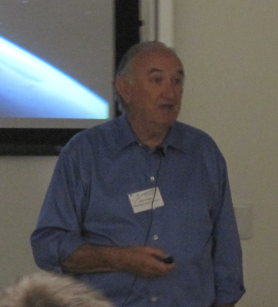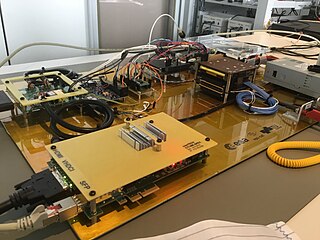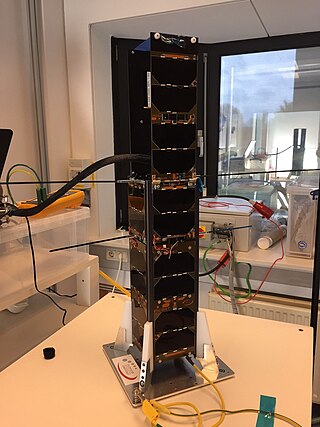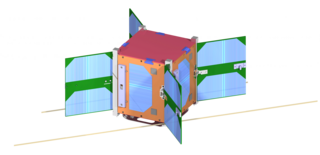Education and career
Cahoy attended Cornell University for her Bachelor of Science in electrical engineering and graduated in 2000. She then attended Stanford University for her Master of Science (2002) and Ph.D. (2008) both in electrical engineering. [2] At Stanford, she served as a graduate research assistant for several courses in the Department of Electrical Engineering. Additionally, it was there that Cahoy continued combining her passions for electrical engineering and aerospace as she studied how we could learn more about weather on planets beyond Earth using instrumentation like satellite radio signals. [2] Her dissertation was entitled Characterization of thermal tides at ionospheric altitudes on Mars with Mars Global Surveyor Radio Occultation measurements of electron density and her principal adviser was emeritus Professor G. Leonard Tyler. From 2006 to 2008, she served as a Senior Communication Sciences Specialist and Senior Engineering Specialist at Space Systems Loral. After finishing her Ph.D., she served as a NASA Postdoctoral Program Fellow in Moffet Field, California where she focused on studying exoplanets through direct imaging of exoplanets and modeling exoplanet atmospheres. [3]
Cahoy started her career at MIT in June 2010 on the research staff in Earth and Planetary Sciences affiliated with the NASA Goddard Space Flight Center. [2] In July 2011, she became an assistant professor of Aeronautics and Astronautics. At that time, she also became the director of the MIT Space Telecommunications, Astronomy and Radiation Laboratory (STAR). In July 2016, she became an associate professor of Aeronautics and Astronautics, and in July 2023, she became a full Professor of Aeronautics and Astronautics. In November 2023, she was titled the Associate Department Head. She is also a faculty member in the Space Systems Laboratory at MIT and a co-director of the Small Satellite Collaborative at MIT.
Research and work
Research and STAR Laboratory
Cahoy's research has investigated heavily in technology demonstrations with nanosatellites, or CubeSat platforms. She directs the STAR lab at MIT which is focused on four key areas: weather sensing, connectivity, exoplanet detection and characterization, and nanosatellite technology. [4] Her work aims to get groups, or "constellations" of the small satellites to work together to gather data to inform research on the applications mentioned.
One of these CubeSat platforms called DeMi was launched from Wallops Island, Virginia in February 2020. On this CubeSat is a deformable mirror that can help in detecting exoplanets and picturing distant stars. [5] Cahoy and her students will continue to study the data from DeMi in the coming years.
One element of her research is to develop and enhance laser communication terminals and ground stations so that the groups of satellites can have crosslink communications. [4] This enables the satellites to have joint observations. Cahoy currently serves as the Principal Investigator for multiple NASA missions related to laser communication including "Miniature Optical Steered Antenna for Intersatellite Communication" (MOSAIC) and "CubeSat Laser Infrared CrosslinK" (CLICK). [6]
Cahoy's research is also influential in the field of exoplanet detection and characterization especially in the realm of imaging and detecting exoplanets. Her lab has contributed to missions including NASA's Transiting Exoplanet Survey Satellite (TESS) and Laser Guide Star for Large Aperture Segmented Space Telescopes (LGS). [6]
Her research also contributes to the field of weather sensing in which she studies how CubeSats (or small satellites) with instrumentation for weather sensing "can passively make precise measurements of atmospheric temperature at different altitudes". [4] Her team has flown 3 CubeSats so far, and the success has proven that these smaller scale satellites can oftentimes provide comparable data to that of larger instruments or spacecraft. [6] In October 2019, Cahoy gave a TED Talk called "How Tiny Satellites Can Help Us Weather Through Hurricanes". She discussed how large satellites that collect data for weather forecasting can leave large gaps of data in areas that happen to be most affected by hurricanes. To fix this problem, there needs to be more satellites which are not only costly but can take a while to build. Not only can the smaller CubeSats help fill in the gap of this data, but also they are less costly. [7]
Notable Publication
Cahoy's most cited work is Thermal emission and reflected light spectra of super Earths with flat transmission spectra published in 2015 in The Astrophysics Journal. The work studies "Super Earths" and models to predict "their transmission, thermal emission and reflected light spectra." [8] The work currently has over 230 citations.
SpaceRake
Cahoy is also a co-founder of SpaceRake, which specializes in laser communication technologies. The company is currently working on three main endeavors: (1) Cubesat-Compatible Terminal, Human-Portable Lasercom Ground Terminal, and Multi-Access Router Architecture. [9] In November 2023, SpaceRake was awarded their first government contract. It awarded them $1.8 million for the purposes of developing "miniature laser communications terminals." [10]

A CubeSat is a class of miniaturized satellite with a form factor of 10 cm (3.9 in) cubes. CubeSats have a mass of no more than 2 kg (4.4 lb) per unit, and often use commercial off-the-shelf (COTS) components for their electronics and structure. CubeSats are put into orbit by deployers on the International Space Station, or launched as secondary payloads on a launch vehicle. As of December 2023, more than 2,300 CubeSats have been launched.

A small satellite, miniaturized satellite, or smallsat is a satellite of low mass and size, usually under 1,200 kg (2,600 lb). While all such satellites can be referred to as "small", different classifications are used to categorize them based on mass. Satellites can be built small to reduce the large economic cost of launch vehicles and the costs associated with construction. Miniature satellites, especially in large numbers, may be more useful than fewer, larger ones for some purposes – for example, gathering of scientific data and radio relay. Technical challenges in the construction of small satellites may include the lack of sufficient power storage or of room for a propulsion system.

Robert J. Twiggs is an American professor of Astronautics and Space Science at Morehead State University. He is responsible, along with Jordi Puig-Suari of California Polytechnic State University, for co-inventing the CubeSat reference design for miniaturized satellites which became an Industry Standard for design and deployment of the satellites.
ITUpSAT1, short for Istanbul Technical University picoSatellite-1, is a single CubeSat built by the Faculty of Aeronautics and Astronautics at the Istanbul Technical University. It was launched on 23 September 2009 atop a PSLV-C14 satellite launch vehicle from Satish Dhawan Space Centre, Sriharikota, Andhra Pradesh in India, and became the first Turkish university satellite to orbit the Earth. It was expected to have a minimum of six-month life term, but it is still functioning for over two years. It is a picosatellite with side lengths of 10 centimetres (3.9 in) and a mass of 0.990 kilograms (2.18 lb).

SARAL is a cooperative altimetry technology mission of Indian Space Research Organisation (ISRO) and Centre National d'Études Spatiales (CNES). SARAL performs altimetric measurements designed to study ocean circulation and sea surface elevation.
Sigrid Close is a professor in the Department of Aeronautics and Astronautics at Stanford University. Her primary research interest is the space environment with particular focus on meteoroids, meteors, and orbital debris, and their interaction with spacecraft and spacecraft operations.
Jordi Puig-Suari is a professor and aerospace technology developer. He is the co-inventor of the CubeSat standard together with Bob Twiggs, and the co-founder of Tyvak Nano-Satellite Systems.

OPS-SAT is a CubeSat by the European Space Agency (ESA) and it is intended to demonstrate the improvements in mission control capabilities that will arise when satellites can fly more powerful on-board computers. The mission has the objective to break the cycle of "has never flown, will never fly" in the area of satellite control. It was the first CubeSat operated directly by ESA.

BGUSAT was an Israeli research CubeSat built by the IAI and Ben Gurion University.

David W. Miller is an American aerospace engineer who is the current Jerome Hunsaker Professor of Aeronautics and Astronautics at Massachusetts Institute of Technology and an elected Fellow of the American Institute of Aeronautics and Astronautics since 2015. He is currently on a leave of absence from MIT to be a VP and the Chief Technology Officer to The Aerospace Corporation. He has worked on multiple NASA projects and served as NASA Chief Technologist.

PicSat is a French observatory nanosatellite, designed to measure the transit of Beta Pictoris b, an exoplanet which orbits the star Beta Pictoris.

ASTERIA was a miniaturized space telescope technology demonstration and opportunistic science mission to conduct astrophysical measurements using a CubeSat. It was designed in collaboration between the Massachusetts Institute of Technology (MIT) and NASA's Jet Propulsion Laboratory. ASTERIA was the first JPL-built CubeSat to have been successfully operated in space. Originally envisioned as a project for training early career scientists and engineers, ASTERIA's technical goal was to achieve arcsecond-level line-of-sight pointing error and highly stable focal plane temperature control. These technologies are important for precision photometry, i.e., the measurement of stellar brightness over time. Precision photometry, in turn, provides a way to study stellar activity, transiting exoplanets, and other astrophysical phenomena.
UBAKUSAT was a Turkish nanosatellite that was developed by Istanbul Technical University. It was launched into space on board a Falcon-9 rocket in April 2018 and was deployed into its orbit from the International Space Station in May 2018. It was built as a technology demonstration and Earth observation satellite to provide voice communications for amateur radio stations around the world. It carried an experimental card, TAMSAT Simplesat, which allowed scientists to test its accuracy of measuring radiation from space. It was the fifth satellite to be built by students of Istanbul Technical University.
IRVINE02 is an educational 1U CubeSat mission that gives high school students the experience of building, testing, and controlling a nano-satellite to develop interest and talent in the science and engineering fields. The mission features the second orbital ion electrospray thruster developed by Accion Systems. Beyond the thruster, IRVINE02 utilizes magnetorquers, deployable solar arrays, a GPS unit, and a miniaturized 1.4 Watt blue laser communication module to transmit pictures and data back to Earth. The magnetorquers and the laser are both developed by the Ecuadorian Space Agency. This laser made IRVINE02 the first 1U cubesat to fly with an orbit-to-ground laser communications device. It transmits data and pictures to the Earth much faster than radio.
NASA's Pathfinder Technology Demonstrator (PTD) Project will test the operation of a variety of novel technologies on a type of nanosatellites known as CubeSats, providing significant enhancements to the performance of these versatile spacecraft. Each of the five planned PTD missions consist of a 6-unit (6U) CubeSat with expandable solar arrays.

Simulation-to-Flight 1 (STF-1) is a microsatellite built by the Katherine Johnson Independent Verification and Validation Facility (IV&V) in Fairmont, West Virginia with the collaboration of the West Virginia Space Grants Consortium and West Virginia University.

OroraTech is a German aerospace start-up company providing wildfire monitoring by employing nanosatellites. It was founded in 2018 as a university spin-off at the Technical University of Munich (TUM). The headquarters are in Munich, Germany. In June 2023, OroraTech joined the Copernicus Programme of the European Space Agency.

The Space Systems Laboratory (SSL) is in the Department of Aeronautics and Astronautics at the Massachusetts Institute of Technology in Cambridge, MA. Its mission is to develop the technology and systems analysis associated with small spacecraft, precision optical systems, and International Space Station technology research and development.

SpaceX CRS-27, also known as SpX-27, was a Commercial Resupply Service mission to the International Space Station (ISS) launched on 15 March 2023. The mission was contracted by NASA and was flown by SpaceX using Cargo Dragon C209. This was the seventh flight for SpaceX under NASA's CRS Phase 2.
Akshata Krishnamurthy is an American space systems engineer and scientist at the NASA Jet Propulsion Laboratory. Born in India, Krishnamurthy has worked on Mars 2020, NISAR, TESS and ASTERIA missions.












